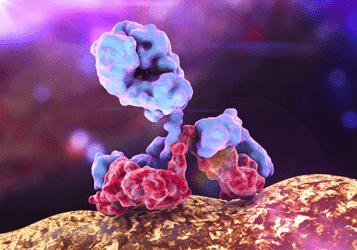- Home
- Products
- Customized ADCs
- MUC16
- Anti-MUC16 (Oregovomab)-SMCC-DM1 ADC
Anti-MUC16 (Oregovomab)-SMCC-DM1 ADC (CAT#: ADC-W-1646)
This ADC product is comprised of an anti-MUC16 monoclonal antibody conjugated via a SMCC linker to DM1. The DM1 is targeted to certain cancers by immunerecognition and delivered into cancer cells via receptor mediated endocytosis. Within the cell, DM1 binds to tubulins, interrupts microtubule dynamics, and subsequently, induces cell death.
- ADC Target
- ADC Antibody
- ADC Linker
- ADC payload drug
- Name
- MUC16
- Alternative Names
- MUC16; mucin 16, cell surface associated; mucin-16; CA125; FLJ14303; CA-125; MUC-16; CA125 ovarian cancer antigen; ovarian carcinoma antigen CA125; ovarian cancer-related tumor marker CA125;
- Target Entrez Gene ID
- 94025
- Target UniProt ID
- Q8WXI7
- Overview
- This gene encodes a protein that is a member of the mucin family. Mucins are high molecular weight, O-glycosylated proteins that play an important role in forming a protective mucous barrier, and are found on the apical surfaces of the epithelia. The encoded protein is a membrane-tethered mucin that contains an extracellular domain at its amino terminus, a large tandem repeat domain, and a transmembrane domain with a short cytoplasmic domain. The amino terminus is highly glycosylated, while the repeat region contains 156 amino acid repeats unit that are rich in serines, threonines, and prolines. Interspersed within the repeats are Sea urchin sperm protein Enterokinase and Agrin (SEA) modules, leucine-rich repeats and ankyrin (ANK) repeats. These regions together form the ectodomain, and there is a potential cleavage site found near an SEA module close to the transmembrane domain. This protein is thought to play a role in forming a barrier, protecting epithelial cells from pathogens. Products of this gene have been used as a marker for different cancers, with higher expression levels associated with poorer outcomes.
- Overview
- Humanized Anti-MUC16 IgG1-kappa antibody, Oregovomab
- Generic name
- Oregovomab
- Host animal
- Mouse
- Name
- SMCC (N-succinimidyl 4-(Nmaleimidomethyl)cyclohexane-1-carboxylate)
- Description
- Disulfide Linkers, are extensively exploited as a chemically labile linkage. Since the release of disulfide-linked drugs requires a cytoplasmic thiol cofactor, such as glutathione (GSH). Disulfides maintain stable at physiological pH and only when ADCs are internalized inside cells, the cytosol provides reducing environment including intracellular enzyme protein disulfide isomerase, or similar enzymes, drugs can be released.
- Name
- DM1 (N2'-Deacetyl-N2'-(3-mercapto-1-oxopropyl)maytansine)
- Description
- Derived from Maytansinoid,a group of cytotoxins structurally similar to rifamycin, geldanamycin, and ansatrienin. The eponymous natural cytotoxic agent maytansine is a 19-member lactam (ansa macrolide) structure originally isolated from the Ethiopian shrub Maytenus ovatus. Maytansinoids can bind to tubulin at or near the vinblastine-binding site, which interfere the formation of microtubules and depolymerize already formed microtubules, inducing mitotic arrest in the intoxicated cells.
For Research Use Only. NOT FOR CLINICAL USE.
Related Products
- Anti-PCSK9 SMCC-DM1 ADC (CAT#: ADC-W-1682)
- Anti-FGFR2-sulfo-SMCC-DM1 ADC-5 (CAT#: ADC-W-055)
- Anti-TPBG-VC-MMAD ADC-1 (CAT#: ADC-W-003)
- Anti-S. epidermidis LTA (Pagibaximab)-MC-MMAF ADC (CAT#: ADC-W-2260)
- Anti-CD3E (Foralumab)-MC-Vc-PAB-SN38 ADC (CAT#: ADC-W-840)
- Anti-TAG-72 (Minretumomab)-MC-Vc-PAB-MMAE ADC (CAT#: ADC-W-1991)
- Anti-CD3E (Catumaxomab)-MC-MMAF ADC (CAT#: ADC-W-2272)
- Anti-CD22-Mc-MMAF ADC-8 (CAT#: ADC-W-192)
- Anti-HBV surface antigen (Libivirumab)-SMCC-DM1 ADC (CAT#: ADC-W-1970)
- Anti-CEACAM1 (Arcitumomab)-SPDB-DM4 ADC (CAT#: ADC-W-963)
Published Data
+ Submit Publications

Scientific Resources
Customer Reviews and FAQs
There are currently no Customer reviews or questions for ADC-W-1646. Click the button above to contact us or submit your feedback about this product.
Quick Links
Other Products
Same Target
Same Linker
Same Payload
| CAT# | Product Name | Linker | Payload |
| ADC-W-564 | Anti-MUC16-VC-MMAE ADC | VC (valine-citrulline) | MMAE (Monomethyl auristatin E) |
| ADC-W-1649 | Anti-MUC16 (Oregovomab)-MC-Vc-PAB-MMAE ADC | MC-Vc-PAB (maleimidocaproyl-valine-citrulline-p-aminobenzoyloxycarbonyl) | MMAE |
| ADC-W-1643 | Anti-MUC16 (Igovomab)-MC-Vc-PAB-MMAE ADC | MC-Vc-PAB (maleimidocaproyl-valine-citrulline-p-aminobenzoyloxycarbonyl) | MMAE |
| ADC-W-2567 | Anti-MUC16 (Sofituzumab)-MC-MMAF ADC | MC (maleimidocaproyl) | MMAF |
| ADC-W-1645 | Anti-MUC16 (Igovomab)-MC-Vc-PAB-DMEA-(PEG2)-duocarmycin SA ADC | MC-Vc-PAB-DMEA-(PEG2) | duocarmycin SA |
| CAT# | Product Name | Linker | Payload |
| ADC-W-603 | Anti-FOLH1-SMCC-DM1 ADC-3 | SMCC (N-succinimidyl 4-(Nmaleimidomethyl)cyclohexane-1-carboxylate) | DM1 (N2’-Deacetyl-N2’-(3-mercapto-1-oxopropyl)maytansine) |
| ADC-W-2604 | Anti-ITGB3 (Tadocizumab)-SMCC-DM1 ADC | SMCC (N-succinimidyl 4-(Nmaleimidomethyl)cyclohexane-1-carboxylate) | DM1 (N2'-Deacetyl-N2'-(3-mercapto-1-oxopropyl)maytansine) |
| ADC-W-2589 | Anti-EGFR (Cetuximab)-SMCC-DM1 ADC | SMCC (N-succinimidyl 4-(Nmaleimidomethyl)cyclohexane-1-carboxylate) | DM1 (N2'-Deacetyl-N2'-(3-mercapto-1-oxopropyl)maytansine) |
| ADC-W-2598 | Anti-GPNMB (Glembatumumab)-SMCC-DM1 ADC | SMCC (N-succinimidyl 4-(Nmaleimidomethyl)cyclohexane-1-carboxylate) | DM1 (N2'-Deacetyl-N2'-(3-mercapto-1-oxopropyl)maytansine) |
| ADC-W-2610 | Anti-MS4A1 (Rituximab)-SMCC-DM1 ADC | SMCC (N-succinimidyl 4-(Nmaleimidomethyl)cyclohexane-1-carboxylate) | DM1 (N2'-Deacetyl-N2'-(3-mercapto-1-oxopropyl)maytansine) |
| CAT# | Product Name | Linker | Payload |
| ADC-W-2598 | Anti-GPNMB (Glembatumumab)-SMCC-DM1 ADC | SMCC (N-succinimidyl 4-(Nmaleimidomethyl)cyclohexane-1-carboxylate) | DM1 (N2'-Deacetyl-N2'-(3-mercapto-1-oxopropyl)maytansine) |
| ADC-W-2583 | Anti-EGFR (Zalutumumab)-SMCC-DM1 ADC | SMCC (N-succinimidyl 4-(Nmaleimidomethyl)cyclohexane-1-carboxylate) | DM1 (N2'-Deacetyl-N2'-(3-mercapto-1-oxopropyl)maytansine) |
| ADC-W-2610 | Anti-MS4A1 (Rituximab)-SMCC-DM1 ADC | SMCC (N-succinimidyl 4-(Nmaleimidomethyl)cyclohexane-1-carboxylate) | DM1 (N2'-Deacetyl-N2'-(3-mercapto-1-oxopropyl)maytansine) |
| ADC-W-2548 | Anti-CD74-SMCC-DM1 ADC | SMCC (N-succinimidyl 4-(Nmaleimidomethyl)cyclohexane-1-carboxylate) | DM1 (N2'-Deacetyl-N2'-(3-mercapto-1-oxopropyl)maytansine) |
| ADC-W-2589 | Anti-EGFR (Cetuximab)-SMCC-DM1 ADC | SMCC (N-succinimidyl 4-(Nmaleimidomethyl)cyclohexane-1-carboxylate) | DM1 (N2'-Deacetyl-N2'-(3-mercapto-1-oxopropyl)maytansine) |
Online Inquiry
Welcome! For price inquiries, please feel free to contact us through the form on the left side. We will get back to you as soon as possible.



